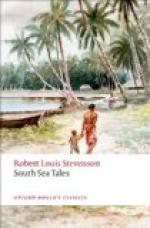We had but just repeated our manoeuvre and kept away—for not more than five minutes the railway embankment had been lost to view and the surf to hearing—when I was aware of land again, not only on the weather bow, but dead ahead. I played the part of the judicious landsman, holding my peace till the last moment; and presently my mariners perceived it for themselves.
‘Land ahead!’ said the steersman.
‘By God, it’s Kauehi!’ cried the mate.
And so it was. And with that I began to be sorry for cartographers. We were scarce doing three and a half; and they asked me to believe that (in five minutes) we had dropped an island, passed eight miles of open water, and run almost high and dry upon the next. But my captain was more sorry for himself to be afloat in such a labyrinth; laid the Casco to, with the log line up and down, and sat on the stern rail and watched it till the morning. He had enough of night in the Paumotus.
By daylight on the 9th we began to skirt Kauehi, and had now an opportunity to see near at hand the geography of atolls. Here and there, where it was high, the farther side loomed up; here and there the near side dipped entirely and showed a broad path of water into the lagoon; here and there both sides were equally abased, and we could look right through the discontinuous ring to the sea horizon on the south. Conceive, on a vast scale, the submerged hoop of the duck-hunter, trimmed with green rushes to conceal his head—water within, water without—you have the image of the perfect atoll. Conceive one that has been partly plucked of its rush fringe; you have the atoll of Kauehi. And for either shore of it at closer quarters, conceive the line of some old Roman highway traversing a wet morass, and here sunk out of view and there re-arising, crowned with a green tuft of thicket; only instead of the stagnant waters of a marsh, the live ocean now boiled against, now buried the frail barrier. Last night’s impression in the dark was thus confirmed by day, and not corrected. We sailed indeed by a mere causeway in the sea, of nature’s handiwork, yet of no greater magnitude than many of the works of man.
The isle was uninhabited; it was all green brush and white sand, set in transcendently blue water; even the coco-palms were rare, though some of these completed the bright harmony of colour by hanging out a fan of golden yellow. For long there was no sign of life beyond the vegetable, and no sound but the continuous grumble of the surf. In silence and desertion these fair shores slipped past, and were submerged and rose again with clumps of thicket from the sea. And then a bird or two appeared, hovering and crying; swiftly these became more numerous, and presently, looking ahead, we were aware of a vast effervescence of winged life. In this place the annular isle was mostly under water, carrying here and there on its submerged line a wooded islet. Over one of these the birds hung and flew with an




